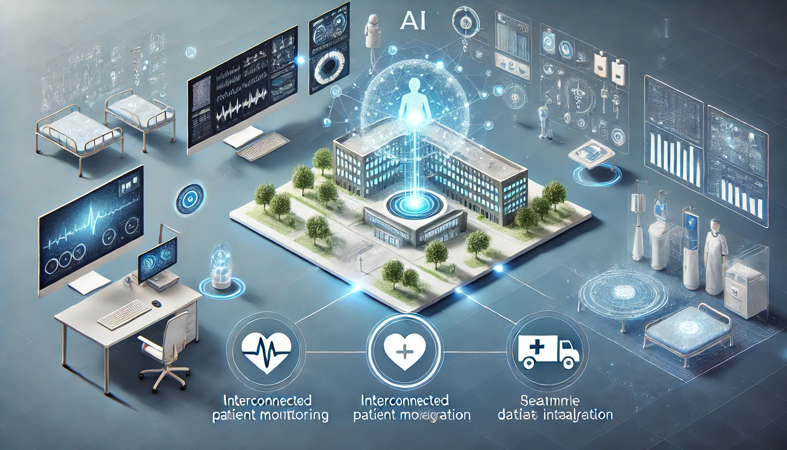Let’s be real—most healthcare leaders aren’t losing sleep over AI in remote patient monitoring. What keeps them up at night? Readmission penalties, staff burnout, and the nagging suspicion that their current RPM setup is just a glorified data dump.
AI promises to change that, but not in the vague, buzzword-filled way most vendors pitch it. Done right, AI in remote patient monitoring doesn’t just generate more data—it transforms it into real-time, actionable insights that reduce hospitalizations, optimize staffing, and personalize care. The problem? Most implementations fail because they overwhelm clinicians, lack proper integration, or don’t align with actual patient workflows.
If you’re considering AI-powered RPM, this guide will show you how to do it right. Because the difference between success and failure isn’t the technology itself—it’s how you implement it.
Key Takeaways
- AI Must Reduce Work, Not Add to It
AI patient monitoring should streamline clinical workflows, not burden providers with endless alerts. The most effective AI-powered RPM systems prioritize signal over noise—filtering out irrelevant anomalies and surfacing only high-confidence alerts that require intervention.
- Integration Determines Success
AI in patient monitoring is useless if it operates in a silo. True impact comes from seamless interoperability with EHRs, telehealth platforms, and existing hospital infrastructure. Without proper data exchange, even the most advanced AI models won’t drive meaningful change.
- Compliance and Explainability Are Non-Negotiable
AI remote patient monitoring isn’t just about accuracy—it must also be auditable, interpretable, and compliant with HIPAA, TEFCA, and FDA guidelines. Healthcare providers need AI models that can explain why they flagged a patient, ensuring trust and clinical adoption.
Table of Contents
- Key Components of AI-Powered Remote Patient Monitoring
- 5 Steps to Implement AI in Remote Patient Monitoring
- Execution Strategies for AI-Based Remote Monitoring
- AI in Remote Patient Monitoring Use Cases
- How Topflight Can Help?
Key Components of AI-Powered Remote Patient Monitoring
Remote patient monitoring (RPM) used to be about strapping on a bulky heart monitor and hoping for the best. Now, AI-driven RPM is turning passive data collection into an active, predictive, and personalized system—detecting early warning signs, reducing hospital readmissions, and improving patient outcomes. But what makes AI-driven RPM truly effective?
1. AI Algorithms & Predictive Analytics
At the heart of AI-driven remote patient monitoring are machine learning models that detect patterns and predict potential health issues before they escalate. These algorithms analyze continuous streams of patient data—heart rate trends, blood pressure fluctuations, oxygen saturation levels—to identify anomalies that a human clinician might miss.
By leveraging AI-based remote patient monitoring services, healthcare providers can proactively intervene, reducing hospital admissions and enhancing chronic disease management with real-time insights.
For example:
- AI can flag subtle ECG irregularities that indicate an impending cardiac event.
- ML models can predict deteriorations in COPD patients by analyzing respiratory patterns.
- AI-powered chatbots can assess patient-reported symptoms and escalate high-risk cases to clinicians.
2. Wearable Devices & Sensors
Smartwatches, biosensors, and connected medical devices have evolved from step counters to FDA-cleared clinical-grade tools. Today’s AI-driven RPM systems rely on smartwatches, biosensors, and connected medical devices—key examples of wearable technology in healthcare that transform passive data collection into proactive health management:
- Heart rate & ECG sensors (e.g., Apple Watch, Withings ECG)
- Continuous glucose monitors (e.g., Dexcom, Abbott FreeStyle Libre)
- Blood pressure cuffs (e.g., Omron, QardioArm)
- Smart inhalers & medication adherence trackers (e.g., Propeller Health)
These devices don’t just collect data; they feed AI models that personalize care recommendations, alert providers to potential crises, and automate routine monitoring.
3. Seamless Data Integration with EHRs & Telehealth Platforms
AI is only as good as the data it has access to. Medical device integration software plays a crucial role in ensuring seamless interoperability between RPM devices, EHR systems, and telehealth platforms—enabling real-time, bidirectional data exchange. Key considerations:
- FHIR & TEFCA compliance to ensure smooth interoperability.
- Secure API integrations for real-time patient data syncing.
- AI-powered dashboards that provide actionable insights without overloading clinicians.
Without seamless integration, RPM risks becoming yet another isolated dataset rather than a proactive clinical tool.
4. Regulatory & Compliance Considerations
AI-driven RPM must navigate a maze of regulations to stay compliant:
- HIPAA: Ensuring patient data privacy and security.
- TEFCA: Enabling nationwide interoperability for seamless data exchange.
- FDA & AI Governance: AI models must be explainable, auditable, and continuously validated to prevent bias and ensure safety.
Healthcare CIOs and tech leaders should build AI strategies with compliance in mind from Day 1—not as an afterthought.
5. Personalized Patient Monitoring
One-size-fits-all AI doesn’t work in healthcare. AI models must adapt to:
- Age and gender differences (e.g., heart rate variability in men vs. women).
- Chronic conditions (e.g., diabetes, hypertension, CHF).
- Medication adherence patterns (AI can flag patients at risk of non-compliance).
By tailoring AI-driven insights to individual patient profiles, RPM moves beyond generic alerts and delivers truly personalized care recommendations.
5 Steps to Implement AI in Remote Patient Monitoring
Implementing remote patient monitoring with AI isn’t just about slapping a predictive model onto patient data and calling it a day. It requires careful planning, execution, and iteration to ensure AI enhances patient monitoring and diagnostics without overwhelming providers or introducing compliance risks.
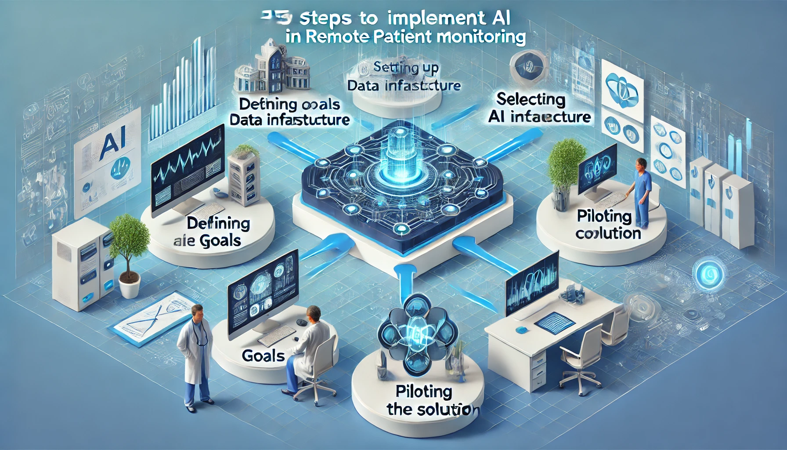
Here’s a step-by-step breakdown to get AI-based remote patient monitoring right.
| Step | Key Action | Summary |
| Step 1: Define Goals & Use Cases | Identify AI’s role in RPM | Align AI implementation with clinical workflows, focusing on chronic disease management, post-op monitoring, and early warning systems. |
| Step 2: Ensure Data Infrastructure Readiness | Set up seamless data pipelines | Ensure EHR compatibility, secure real-time data ingestion, and maintain high-quality inputs for AI models. |
| Step 3: Choose AI Models & Vendors Wisely | Select AI models and vendors carefully | Consider explainability, vendor lock-in risks, and interoperability to ensure long-term success. |
| Step 4: Pilot Testing & Scaling Up | Start small before full deployment | Run a pilot on a single patient cohort, optimize workflows, and gather provider feedback before scaling. |
| Step 5: Address Compliance, Security & User Adoption | Prioritize trust, security, and compliance | Ensure HIPAA, TEFCA, and FDA compliance while training staff to integrate AI effectively into clinical workflows. |
Step 1: Define Goals & Use Cases
Before diving into AI implementation, healthcare leaders must pinpoint what they want AI to achieve in RPM. Whether it’s remote patient monitoring app development for chronic disease management or AI-powered post-operative monitoring, defining clear use cases ensures alignment with clinical workflows. Common use cases include:
- Chronic disease management (diabetes, hypertension, COPD)
- Post-operative monitoring (reducing readmissions, early complication detection)
- Early warning systems (AI-driven alerts for sepsis, cardiac events)
- Medication adherence tracking (detecting missed doses, optimizing treatment plans)
The key here is alignment with clinical workflows—AI should enhance patient outcomes without adding unnecessary friction to existing care models.
Step 2: Ensure Data Infrastructure Readiness
AI thrives on clean, structured, and interoperable data—which is easier said than done in healthcare. To avoid data silos and integration headaches:
- Ensure EHR compatibility & health records accessibility (FHIR & TEFCA compliance).
- Set up secure real-time data pipelines to ingest sensor, lab results, and patient-reported data.
- Implement data normalization & validation to maintain high-quality inputs for AI models.
Without proper data infrastructure, AI risks being another fragmented tool rather than an integral part of patient monitoring and diagnostics.
Step 3: Choose AI Models & Vendors Wisely
Selecting the right AI approach is critical:
- Custom AI vs. Off-the-Shelf Models: Custom models offer flexibility but require longer development cycles; off-the-shelf solutions are faster but may lack specificity for certain conditions.
- Explainability & Interpretability: AI models should be clinically interpretable—black-box AI won’t fly in regulated healthcare settings.
- Vendor Lock-in Risks: Opt for interoperable AI solutions that don’t create long-term dependencies on proprietary platforms.
Decision-makers should evaluate vendors based on scalability, integration capabilities, and compliance readiness—not just flashy AI demos.
Step 4: Pilot Testing & Scaling Up
Jumping straight to full deployment is a recipe for failure. Instead:
- Start with a small-scale pilot focused on a single condition or patient cohort.
- Monitor AI accuracy & reliability (false positives/negatives can erode trust).
- Optimize workflows—ensure AI-generated insights are actionable and fit seamlessly into existing clinical processes.
- Gather provider & patient feedback before expanding system-wide.
AI success in remote patient monitoring with AI isn’t just about performance metrics—it’s about usability and practical impact on patient care.
Step 5: Address Compliance, Security & User Adoption
Even the most sophisticated AI won’t succeed if it lacks trust and compliance safeguards. Critical considerations include:
- Regulatory compliance: HIPAA, TEFCA, and FDA guidelines for AI in healthcare.
- Cybersecurity: Data encryption, secure APIs, and multi-factor authentication to protect patient data.
- Medical staff training: AI should augment—not replace—clinicians. Ensuring staff understands how to use AI outputs effectively is key to adoption.
The best AI-powered remote patient monitoring solutions don’t just work technically—they work for people.
Also Read: HIPAA Compliant App Development Guide
Following these five steps ensures AI in remote patient monitoring is implemented strategically, efficiently, and responsibly—unlocking its full potential to transform patient monitoring and diagnostics. Next, we’ll cover how to execute and optimize AI-powered RPM at scale while mitigating common pitfalls.
Execution Strategies for AI-Based Remote Monitoring
Implementing AI for remote patient monitoring is only half the battle. The real challenge lies in execution—rolling out AI-powered RPM without disrupting clinical workflows, ensuring seamless adoption, and maximizing its impact on patient outcomes. Here’s how to do it right.
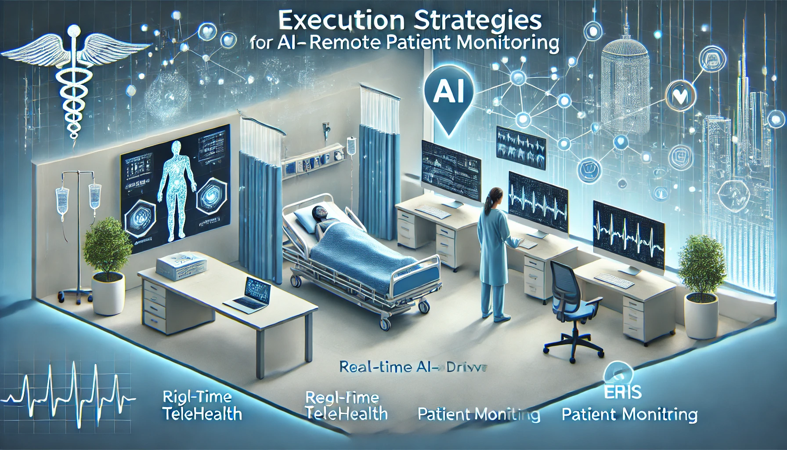
Best Practices for Deployment
AI-powered RPM should complement existing workflows, not disrupt them. With IoT telehealth integration, patient vitals can be continuously streamed from connected devices to care teams, enabling proactive intervention without requiring in-person visits. To ensure a smooth rollout:
- Integrate AI into existing workflows – AI should complement clinical processes, not force clinicians to change their routines. Seamless integration with EHRs and telehealth platforms is a must.
- Start with a phased rollout – Instead of a hospital-wide launch, begin with a specific department or use case (e.g., monitoring post-op patients for early complications).
- Avoid overwhelming staff with alerts – AI-driven RPM should filter out noise and highlight only critical anomalies, reducing alert fatigue rather than adding to it.
- Measure success with clear KPIs – Track AI’s impact on hospital readmission rates, response times to critical alerts, and provider satisfaction with AI-generated insights.
Optimizing AI Outputs for Physician Workflows
Even the best AI-enabled remote patient monitoring won’t succeed if clinicians don’t trust or understand it. Optimizing AI outputs means:
- Prioritizing interpretability
AI recommendations should be transparent, showing why a patient is flagged as high risk. If a model detects an irregular heart rhythm, it should indicate which patterns triggered the alert.
- Reducing cognitive load
Overloading physicians with data defeats the purpose. AI dashboards should provide actionable insights, not just raw patient metrics.
- Enabling physician oversight
AI should assist, not replace, decision-making. RPM systems should allow physicians to override AI alerts based on clinical judgment.
Example: AI detects a patient’s declining oxygen levels but also factors in their medical history before triggering an alert—ensuring that physicians only receive relevant, high-confidence alerts.
Cybersecurity & Privacy Considerations
AI-driven RPM systems are prime targets for cyber threats. Hospitals and healthtech firms must strike a balance between securing patient data and ensuring accessibility for authorized clinicians. Key strategies include:
- End-to-end encryption – Ensures secure data transmission from wearable sensors to hospital servers.
- Role-based access controls (RBAC) – Limits access to sensitive data based on clinical roles (e.g., a nurse sees different data than a cardiologist).
- Continuous AI model monitoring – Cybersecurity threats evolve, and so should AI security protocols. AI should be regularly audited for vulnerabilities.
The Bigger Picture: According to the 2023 State of API Security Report, 60% of organizations experienced at least one API-related data breach in the past two years, and 74% of those faced three or more breaches. This underscores the urgency of proactive security measures—such as penetration testing and API hardening—to mitigate risks in AI-driven RPM systems.
Training & Onboarding Medical Staff
AI adoption fails when clinicians don’t trust or understand the technology. A strong training strategy can mitigate resistance and drive adoption:
- Physician education sessions – AI literacy training should be mandatory, ensuring clinicians grasp how AI interprets patient data.
- Clinical pilot programs – Letting providers use AI in controlled settings fosters confidence before full deployment.
- Real-time AI support – AI tools should offer just-in-time guidance (e.g., a chatbot that answers physician questions about AI-generated recommendations).
Tip: Frame AI as an “augmented intelligence” tool rather than a replacement—this shifts the conversation from fear of automation to improved decision support.
Cost Optimization & ROI Considerations
AI in RPM needs to justify its investment with measurable impact. To optimize cost and ROI:
- Prioritize high-impact AI use cases – Start with applications where AI can deliver the fastest ROI, such as reducing readmissions or optimizing chronic disease management.
- Leverage existing hospital infrastructure – Avoid unnecessary tech stack overhauls. AI should enhance monitoring patients using existing EHRs and telehealth platforms.
- Optimize vendor contracts – Many AI solutions come with hidden costs (e.g., data storage fees, API licensing). Scrutinize vendor agreements to prevent long-term financial drain.
ROI Snapshot: Research published in JMIR Formative Research found that home digital monitoring significantly reduced hospitalizations and emergency department visits for high-risk patients post-discharge, with measurable improvements at both 3 and 6 months after intervention. This reinforces the value of AI-driven RPM in reducing costly hospital readmissions and improving patient outcomes.
Successful execution of AI for remote patient monitoring hinges on a clinician-first approach, strong cybersecurity, and a laser focus on ROI. When done right, AI in RPM doesn’t just improve patient care—it transforms how healthcare providers manage treatment, anomalies, and long-term patient monitoring.
AI in Remote Patient Monitoring Use Cases
AI is already making a tangible impact in remote patient monitoring, shifting it from a reactive system to a proactive, predictive approach. Let’s dive into the real-world use cases where AI-powered RPM is transforming patient care.
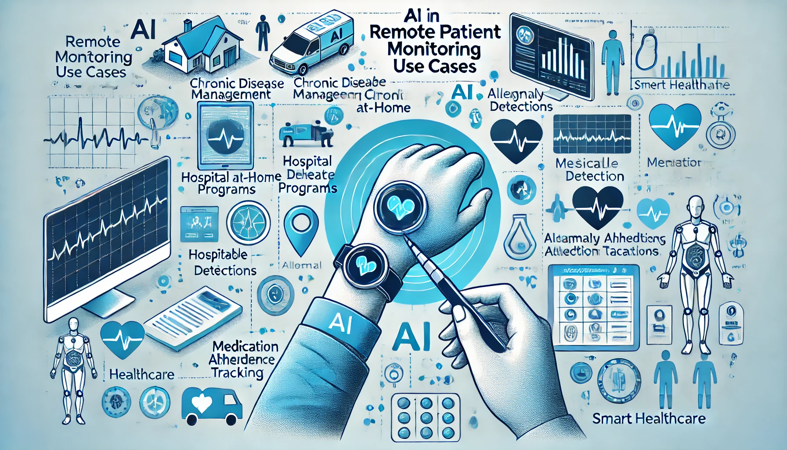
Chronic Disease Management: Keeping Patients Out of the Hospital
Managing chronic conditions like diabetes, hypertension, COPD, and heart failure (CHF) is where AI remote patient monitors shine. Instead of relying on scheduled in-person visits, AI continuously analyzes patient data, detecting patterns that indicate deterioration.
By continuously tracking patients’ health conditions in real time, AI helps care teams detect deterioration early, reducing emergency interventions and hospitalizations.
- Diabetes: AI-driven continuous glucose monitors (CGMs) predict blood sugar fluctuations and suggest lifestyle adjustments, reducing emergency interventions.
- Hypertension: Smart blood pressure cuffs use AI to detect long-term trends, flagging potential hypertensive crises before they happen.
- COPD & CHF: AI models predict exacerbations based on changes in oxygen levels and respiratory patterns, allowing for early intervention and reducing hospitalizations.
Case in point: A study published in the International Journal of Chronic Obstructive Pulmonary Disease found that remote cardiorespiratory monitoring significantly lowered all-cause hospitalization rates among COPD patients.
Hospital-at-Home Programs: Reducing Readmissions with AI
Hospitals are under pressure to reduce readmissions while ensuring continuous care. AI-driven hospital-at-home programs make this possible by:
- Monitoring vitals post-discharge, ensuring recovery is on track.
- Detecting early signs of complications, such as infections or blood clots.
- Automating alerts for caregivers and clinicians, enabling timely interventions.
Example: Mayo Clinic’s Advanced Care at Home program has demonstrated a 15% reduction in readmission rates compared to traditional hospital care, highlighting that AI-enhanced RPM is not just a convenience but a vital necessity.
AI-Powered Anomaly Detection: Catching the Unpredictable
AI doesn’t just track patient vitals—it recognizes dangerous deviations before they escalate.
- Irregular Heart Rhythms: AI can detect atrial fibrillation (AFib) in real time, preventing strokes. Devices like the Apple Watch and KardiaMobile are already FDA-cleared for this.
- Sepsis Prediction: AI models analyze lab results and vitals to detect early signs of sepsis—hours before clinicians would normally identify them.
- Stroke Prevention: AI-powered monitoring tools assess neurological patterns, flagging stroke risks even before visible symptoms appear.
Did you know? A study by Johns Hopkins University implemented a real-time AI system, Targeted Real-Time Early Warning System (TREWS), across five hospitals, reducing sepsis-related mortality by 18.2% through earlier detection and intervention. This AI-driven approach highlights the power of real-time remote patient monitoring in critical care.
Medication Adherence Monitoring: Reducing Missed Doses
Non-adherence to medication costs the U.S. healthcare system over $300 billion annually in avoidable complications and hospitalizations. AI-driven RPM tackles this with:
- Automated Reminders: Smart pill dispensers alert patients when they miss a dose.
- Computer Vision Tracking: AI-enabled cameras verify if a patient has actually taken their medication.
- Behavioral Insights: AI analyzes adherence patterns, sending adaptive nudges based on patient habits.
A win for patient care: AI-based interventions, such as voice assistants and conversational reminder systems, have been shown to improve medication adherence rates by over 30% in chronic disease patients.
AI-Driven Diagnostics & Early Warning Systems
AI isn’t just monitoring—it’s diagnosing. By analyzing biomarkers, symptoms, and real-time patient data, AI helps catch illnesses before they manifest.
- Detecting Infections Before Symptoms Appear: AI models analyze temperature trends, white blood cell counts, and wearable sensor data to predict infections days in advance.
- Automated Wound Monitoring: AI in teledermatology tracks wound healing, ensuring post-surgical patients receive timely interventions.
- Predicting Mental Health Crises: AI-powered behavioral monitoring tools analyze speech patterns and digital biomarkers to detect early signs of depression or suicidal ideation.
Real-world impact: AI-driven early detection considerably reduced severe diabetic foot complications, preventing unnecessary amputations.
AI in RPM is Not the Future—It’s Here
As AI adoption accelerates, artificial intelligence in healthcare patient monitoring is set to become a standard rather than an innovation. Health systems that leverage AI-powered RPM not only improve patient outcomes but also optimize clinical workflows, making remote monitoring more scalable, cost-effective, and proactive.
How Topflight Can Help?
Successfully implementing AI-powered remote patient monitoring requires expertise in healthcare app development—from designing intuitive patient-facing apps to integrating AI-driven analytics within clinician workflows.
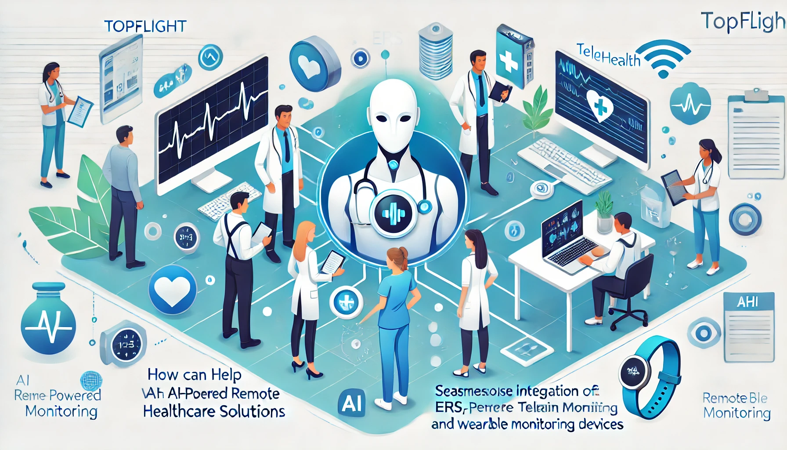
Healthcare organizations need solutions that seamlessly integrate into existing clinical workflows, prioritize data security, and scale without locking them into rigid vendor ecosystems.
Tailored AI Solutions for RPM Challenges
One-size-fits-all AI rarely works in healthcare. We develop custom AI models designed for RPM’s unique demands—whether it’s predictive analytics for chronic disease management or anomaly detection for hospital-at-home programs. More importantly, our AI solutions emphasize explainability and compliance, ensuring clinicians understand and trust AI-driven insights.
We’ve helped build AI-powered RPM solutions like AllHeartz, an AI-driven computer vision remote therapeutic monitoring (RTM) app that uses motion-tracking technology to analyze patient movements in real-time, improving remote rehabilitation programs.
Our team of healthcare app developers specializes in building AI-driven RPM solutions that not only detect anomalies but also ensure that insights are actionable, explainable, and seamlessly integrated into existing care models.
Seamless EHR & Telehealth Integration
An AI-driven RPM solution is only as good as its ability to communicate with existing systems. Our approach focuses on:
- Interoperability-first development, ensuring real-time data exchange with EHRs via FHIR-compliant APIs.
- Telehealth synchronization, allowing providers to act on AI-generated insights instantly.
- Custom dashboards, designed to surface critical alerts without overwhelming clinicians with unnecessary data.
Privacy-First AI Implementation
Data security is non-negotiable. Our AI implementations follow a privacy-by-design approach, adhering to:
- HIPAA and TEFCA compliance
- End-to-end encryption for all AI RPM transmissions.
- Role-based access controls, etc.
Scalable, Cost-Effective RPM Solutions
AI should enhance—not complicate—your organization’s RPM strategy. Our solutions prioritize:
- Flexible architectures that reduce long-term vendor lock-in.
- Modular AI capabilities, so you can scale based on evolving needs.
- ROI-driven AI adoption, ensuring investments in AI-powered remote patient monitoring translate to better outcomes and cost savings.
Healthcare leaders know that AI isn’t just an option anymore—it’s an operational necessity. The real question is: Are you implementing it the right way? Let’s build an AI-powered RPM system that works for your clinicians, your patients, and your bottom line.
Frequently Asked Questions
What's the biggest challenge in implementing AI in remote patient monitoring?
The biggest hurdle isn’t the technology—it’s workflow integration. If AI disrupts existing clinical routines instead of enhancing them, adoption suffers. The key is to design AI tools that fit seamlessly into how providers already work.
How does AI reduce hospital readmissions in RPM?
AI analyzes real-time patient data to detect early warning signs of deterioration, enabling timely interventions. This is especially effective in chronic disease management, where predictive analytics can prevent ER visits.
Can AI in patient monitoring replace human clinicians?
No. AI is a decision support tool, not a replacement. It enhances human oversight by identifying patterns and predicting risks faster, but clinical judgment remains critical for patient care.
What types of AI models work best for RPM?
It depends on the use case. Predictive analytics models are ideal for early warning systems, while machine learning algorithms excel at detecting subtle health trends. Explainable AI is essential for clinical adoption.
How do hospitals justify lower ROI of AI-powered RPM?
Hospitals measure AI’s impact through reduced readmissions, lower clinician workload, and improved patient outcomes. AI-powered RPM has been shown to decrease ER visits and optimize chronic disease management, leading to significant cost savings.
